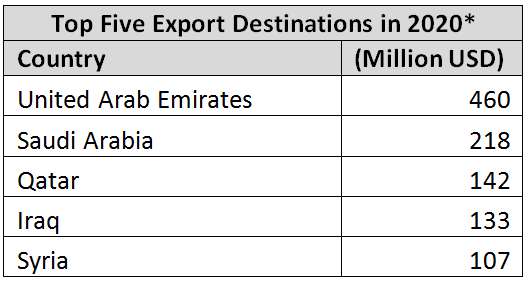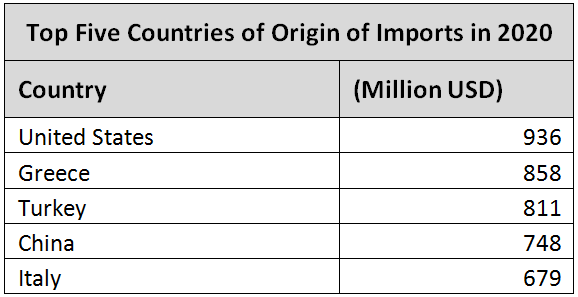Lower purchasing power
has cut trade deficit in half
Exports have not increased despite despite lira collapse
| Share |
|

|
|

|
|
|
|
Real exports, which consist of total exports excluding pearls, precious metals, and petroleum products, decreased 4.6 percent in 2020 to $2.1 billion, according to Customs data. They reflect the combined activity of manufacturing and agriculture. Services are not accounted for.
Real imports, which also exclude the same goods, plummeted 39 percent to $7.2 billion.
Active contraband, into and out of country are not factored into these official figures.
The more substantial decline registered in imports compared with exports has led to a 47 percent narrowing in the Real Trade Deficit to $5.1 billion.
If pearls, precious metals, and petroleum products are factored in, the deficit shrinks by 50 percent to $7.8 billion. Overall imports, including these items, dropped 41 percent to $11.3 billion. Overall exports fell 5.1 percent to $3.5 billion.
The Real Trade Deficit is an indicator measuring trends in actual productive and consumer activity, and excludes items that are chronically under or over reported and which are affected by contraband. It cannot be used in the calculation of the Balance of Payments.

Source: Customs
Despite the sharp decrease in the trade deficit, the deficit in the Balance of Payments widened 80 percent to $10.6 billion in 2020. This is a result of the sharp decline in financial inflows due to the economic and financial crisis.
According to Mounir Bissat, Secretary for Foreign Affairs at the Association of Industrialists, a decline of five percent in exports is not significant taking into consideration that 2020 was not a normal year. “The number of lockdown days exceeded five percent and the financial restrictions imposed by banks have put a pressure on the working capital of manufacturers resulting in reduced activity,” he said.
Bissat said that industrialists, who used to export shipments of four to five containers thanks to credit facilities provided by banks, are now compelled to sell one container at a time. They have to wait to receive the payment from their foreign customer in order to finance the production and export of the second container. Some foreign customers pay after 90 to 100 days. “Even if they pay on delivery, shipments take around 15 days to Arab countries and 60 days to the USA,” Bissat said. “If the depreciation of the lira was not accompanied by capital controls, industrial exports would have witnessed a golden era as had happened in the 1980s when the exchange rate was witnessing sharper fluctuations,” he said.
Major export items include food products and machinery. Exports of prepared foodstuffs, beverages, and tobacco increased one percent to $375 million. Exports of machinery and electrical instruments dropped 18 percent to $312 million.
The exports that witnessed a boom include agricultural products. Fruits and nuts surged 67 percent to $120 million compared with 2019. Exports of live animals almost tripled to $33 million. Ibrahim Tarshishi, Chairman of the Bekaa Farmers Association, said that in the first half of 2020 the costs of farmers were still at relatively lower exchange rates and a large part of dollars were bought at the end of 2019. He said that the pace of the growth in local production of livestock is not enough for tripling exports of live animals and that in the absence of evidence he cannot affirm that imported subsidized livestock were re-exported. Tarshishi said the rise in exports mainly benefited traders and that the subsidies were not provided in an equitable and efficient manner.
Exports of ships, boats and floating structures, which were nil in 2019, totaled $29 million last year. Exports of vehicles almost tripled to $35 million. Elie Azzi, Chairman of the Syndicate of Importers of Used Cars, said that car importers are exporting cars mainly to Europe and the Gulf region in order to secure foreign currencies due to the de facto capital controls. “Another major reason was the almost complete halt in local sales caused by the sharp decline in purchasing power of consumers and economic and security uncertainty,” he said.
Exports of books, newspapers and other products of publishing houses plunged 49 percent to $38 million.
The United Arab Emirates tops the list of export destinations. Most exports to the UAE consist of precious metals which accounted for 68 percent of total Lebanese exports to this country in 2020. In terms of real extorts, major exports to the UAE were essential oils, cosmetics, and pharmaceutical products.

*Switzerland tops the list (when precious metals are factored in). Exports to Switzerland mainly consist of gold
Source: Customs
Major import items include prepared foodstuffs, beverages, and tobacco which plunged by 38 percent to $755 million. Imports of pharmaceutical products fell five percent to $1.2 billion. Imports of vehicles plummeted 61 percent to $431 million.
The United States tops the list of countries of Lebanese imports. Besides petroleum products, major imports from the US include aviation spare parts, medicine, and cars.

Source: Customs
Imports of petroleum products dropped 51 percent. Declared exports of these products decreased by 78 percent amid reportedly continuing large-scale smuggling activities.

Source: Customs
Date Posted: Jun 04, 2021
| Share |
|

|
|

|
|
|
|